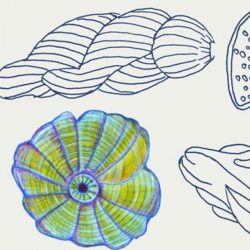This is a guide only – please play and create and make a big mess!
SIZING penetrates the weave of a canvas or the fibers of paper to create a barrier to assist the paint from seeping through the surface. Equipment: 1 small bowl or pot, a spoon and jar with lid.
Ingredients: 1/4 teaspoon of gelatine, one cup of hot water, one drop of essential oil.
Method: Place gelatine in the bowl or pot and pour in hot water. Stir until dissolved and add a drop of essential oil.
Store: Pour into Jar and store, gelatine jells slowly add warm water to liquify.
Best results apply the same day as prepared and warm. Tape sides of paper while drying as there is shrinkage.
GESSO is traditionally used to prepare wooden panels, paper and canvas to add “tooth” enabling the paint to grab to the surface.
Equipment: 1 small bowl, a spoon Ingredients: I cup of warm sizing liquid, 1/2 teaspoon of honey and whiting
Method: Place sizing liquid in the bowl pour in whiting until it resembles the consistency of cream add water if need be. Stir until there are no lumps and even, if let to sit stir again.
Apply immediately does not store. Apply warm to your surface with one to two coats. If applying two coats brush each coat in opposite directions.
Applying sizing and gesso to your surface is optional.
BINDERS are what hold the pigments in suspension. There are many recipes, this recipe is made from traditional methods and food grade materials. Gum Arabic, honey, and essential oil (i.e. lavender, clove or eucalyptus for mould prevention).
Equipment: 1 small bowl, 1 tea cup, eye dropper, 1 small flexible spatula or flexible knife or spoon and small jar with lid.
Ingredients: 1 flat teaspoon of gum Arabic, one cup of warm water, half teaspoon of honey and one drop of essential oil.
Method: Mix Gum Arabic in a tablespoon of the warm water until dissolved using a flexible small spatular. The mixture goes lumpy, squeeze the lumps against the side of the bowl until dissolved, add honey, add essential oil and add the rest of the warm water, mix thoroughly.
Store: Pour into a sterile jar and store a
refrigerator, may need to add a little warm
WATERCOLOUR is as old as the worn hills of Australia, indigenous people have been using watercolour for at least 40,000 years. This watercolour recipe originates in Northern Germany during the 1400’s.
Equipment: Mortar and pestle, eye dropper, small flexible spatula or flexible knife and a suitable storage container i.e. a jar with lid.
Ingredients: 1 teaspoon pigment, 1/8 teaspoon honey and water based binder.
Method: Place dry pigment into the mortar and make an indentation in the middle. With the eye dropper full of binder, mix binder to pigment drop by drop until a smooth paste is formed. If a little lumpy use the pestle to grind the paste. To make the watercolour more flexible add honey. Blend thoroughly until a smooth firm paste. If a little lumpy use the pestle to grind the paste. Scoop up and place in a
suitable container and let dry. To paint, wet brush and mix with watercolour.
Store: In an air tight jar for up to a year.
GOUACHE dates back to Egyptian times when a chalk was added to watercolour to increase its opacity (less see through). “Whiting”- Calcium carbonate has been traditionally used in southern Italy.
Equipment: Mortar and pestle, eye dropper, small flexible spatula or flexible knife and a air tight jar.
Ingredients: 1 teaspoon of pigment, 1/4 teaspoon whiting, 1/8 teaspoon honey and water based binder.
Method: Into the mortar place dry pigment and whiting, mix well. Make an indentation in the middle. With the eye dropper full of binder, mix binder to pigment drop by drop until a smooth paste is formed. If a little lumpy use the pestle to grind the paste. To make the gouache more flexible add honey and blend thoroughly until a smooth firm paste. Scoop up and place in a jar and let dry. To paint, wet brush and mix with gouache.
Store: In an airtight jar
*Remember all fine powders are hazardous in their preparation for use wear a face mask, disposable gloves and glasses while preparing dry ingredients*
OIL PAINT – the type you use is of utmost importance if you don’t want your work to yellow or crack. I use sun drenched linseed oil. You stand the good quality art store linseed oil a sunny window sill in a jar with a cloth over the top until the oil thickens and becomes light in colour. When thicker like liquid glucose put lid on to keep (other oils you can use are sunflower oil, poppy seed oil)
Equipment: Mortar and pestle, eye dropper, small flexible spatula or flexible knife and a suitable storage container i.e. a jar with lid.
Ingredients: pigment, oil – thin with lavender or eucalyptus oil –
Method: Place dry pigment into the mortar and make an indentation in the middle. With the eye dropper full of binder, mix oil to pigment drop by drop until a smooth paste is formed. If a little lumpy use the pestle to grind the paste. Blend thoroughly until a smooth firm paste. Scoop up and place in a suitable container. Thin with lavender oil. (if too thin paint will crack)
Store: In an air tight jar
The longevity is dependant on how sterile, humidity – if animal ingredients are used ie gelatine store in fridge
Source the Artists Handbook by Pip Seymour Pub: Arcturus 2003
Green Guide for artists by Karen Michel Pub: Quarry 2009

